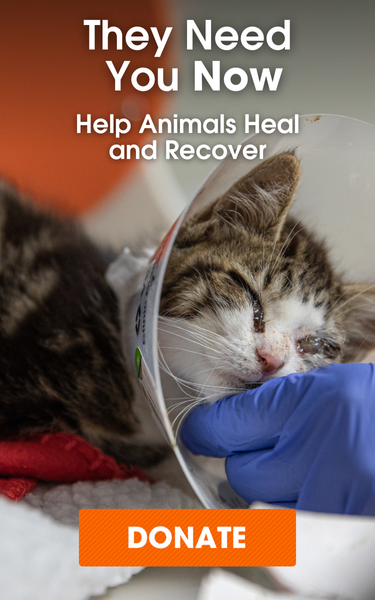
With Help, a Resilient Cat Overcomes Vicious Cruelty

In July 2022, the NYPD received a call from a Bronx resident who witnessed a neighbor swinging his cat by the tail. Police seized the cat and transported her to the ASPCA Animal Hospital.
Dr. Laura Niestat, a Forensic Veterinarian, examined the one-year-old feline named Willow.
“Willow had several injuries to her face,” says Dr. Niestat. “Her upper lip and chin were swollen and bruised, and there was bruising inside her mouth. She also had traumatic injuries to her left eye.”
In addition, Willow had suffered a painful tail pull injury.

“Tail pull injuries occur when a cat’s tail is pulled or broken,” Dr. Niestat explains. “This type of injury is generally associated with major trauma such as being hit by a car, getting caught in a door, and—in cases like Willow’s—intentional harm.”
Willow’s injury caused dysfunction of her tail, bladder and anus due to stretching and damage to the nerves that control these body parts. For several days she was unable to urinate or defecate.
“We didn’t know if Willow would recover from her tail pull injury; some cats with this type of injury never regain full function,” Dr. Niestat adds. “We hoped for the best.”
A Tragic History of Cruelty
X-rays revealed that Willow’s lower right jawbone was broken, and that wasn’t all.
“Willow suffered not only from recently broken bones, but she had injuries from previous trauma, including two broken ribs and a broken right thigh that had healed,” says Dr. Niestat. “These injuries occurred before the tail pull.”

As part of her intake examination, Willow had bloodwork to assess her health and the extent of her injuries.
“Frequently in cases of acute blunt force trauma, bloodwork will reflect damage to the liver and muscles, as was the case with Willow,” says Dr. Aubrey Crowley, Medical Supervisor of the ASPCA Animal Recovery Center (ARC). “However, Willow’s values did not go down over time as expected. We tried medication and added tests for infectious diseases. When these did not resolve her clinical signs, we reached out to an in-house expert.”
That expert was Dr. Sylvia Lesnikowski, Director of Internal Medicine and Clinical Research. Willow underwent a liver biopsy when she was spayed, revealing a microvascular anomaly—an inherited liver abnormality where blood vessels are underdeveloped.

“Fortunately, Willow did now show any signs of liver disease, so we are hopeful this was an incidental finding,” says Dr. Lesnikowski, who also reports that Willow tested positive for Toxoplasmosis, an infectious organism that can enter the muscles and liver. It was treated and eventually cleared.
Caring for Willow
The initial stages of Willow’s care were intense for ARC’s direct care staff.

“We asked the team to check Willow’s litter box frequently for urine or feces during the first two weeks,” Dr. Crowley says. “With a tail pull injury, a common complication is that animals can become incontinent. Fortunately, Willow started using the litter box appropriately within the first few days of her recovery.”
Willow remained at the ASPCA Animal Hospital and ARC as she was treated for her various ailments. Medical staff said she remained trusting and affectionate, always looking for attention. In late August she was placed with a specialized foster caregiver to continue her healing journey.
Finding A Friend
In early January, Manhattan resident Catalina M. browsed the ASPCA website for an adoptable cat.
“I knew I didn’t want a kitten, but I wasn’t picky and applied for an adult cat,” Catalina says. “An ASPCA Matchmaker called me and told me about Willow, who was in foster care. I met her over Facetime. She was cute and had good energy, and her backstory moved me. I knew right away she was the one.”
Catalina, a nurse, works nights and is home during the days with Willow.

“She’ll nap with me and is a cuddler,” says Catalina, who always loved cats even though she grew up with dogs. “Willow always finds her place right by me. She loves watching me cook and lets me know when she’s hungry. She’s very curious but can also entertain herself.”

Willow recovered from her many injuries, including her tail, which healed over time. Not surprisingly, she doesn’t enjoy being picked up.
“I just love her so much,” says Catalina. Willow now has a new name—Indigo.

Consequences for Cruelty
Willow’s prior owner was arrested and pled guilty to an animal-related violation. He surrendered Willow and received a court-ordered animal ban of five years.

“Thankfully, the traumatic event that caused Willow’s injuries was witnessed,” says Dr. Niestat. “In many animal abuse cases, only the perpetrator and the animal victim know what happened. Because animals cannot speak for themselves, it can be challenging to determine what actually occurred. We’re grateful this witness came forward.”

The dedicated medical investigation was also crucial to bring Willow not only care, but justice.
“Willow had both recent and old, healed injuries,” Dr. Niestat adds. Evidence of repeated traumatic events is a red flag and a standout feature of non-accidental injury."

Willow deserves plenty of admiration herself.
“Emerging from horrific cruelty and injury with such a sweet and trusting personality is a remarkable example of animal resilience,” says Dr. Niestat. “Helping her recover and get a second chance to love and be loved meant almost as much to us as it meant to her.”

